If you see the error message Please power down and connect the PCIe Power Cables for this Graphics Card on your Windows 11/10 PC, read this post to learn how to troubleshoot the issue.
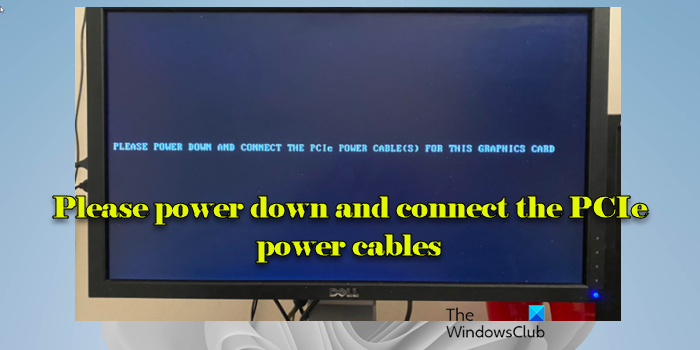
The error appears when a PCIe device, usually a graphics card, isn’t receiving adequate power from the power supply unit (PSU). This can be caused by defective PCIe power cables, missing power connections, or insufficient power supply wattage. The error can also appear if you’ve not connected the power cable correctly. The complete error message reads:
Please power down and connect the PCIe power cable(s) for this graphics card
The error is often encountered by first-time PC builders or those who are less experienced with assembling computer systems when they boot their PC for the first time. The message can also appear if your PCIe cables become loose due to vibrations or movements. In this post, we will discuss the steps you need to take to quickly fix the issue.
Please power down and connect the PCIe Power Cables for this Graphics Card
If your monitor displays ‘Please power down and connect the PCIe Power Cables for this Graphics Card’ when you turn your computer on, use these solutions to fix the issue:
- Check the power connections
- Check your GPU’s power input
- Check the Power Supply Unit
- Use the on-board graphics
- Re-seat the Graphics Card
- Re-insert the CMOS battery
- Contact the manufacturer of your GPU.
Let us see this in detail.
1] Check the power connections
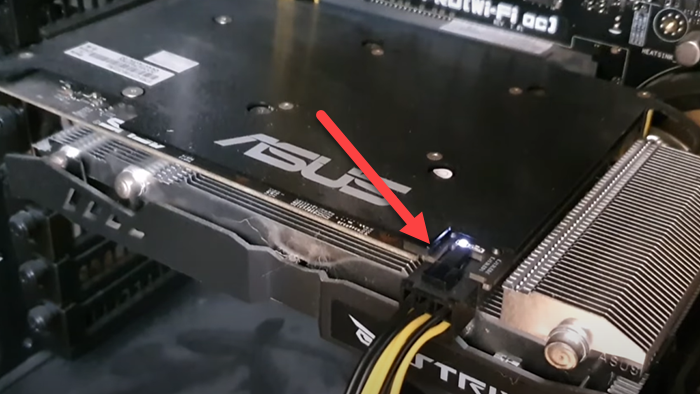
The first thing you need to check to fix the error message ‘Please power down and connect the PCIe power cables’ is your power connections.
- Connect the correct 6-PIN or 8-PIN connector and adapter. Make sure you’re using a PCIe cable connector, not the CPU connector (the CPU connector looks just like the PCIe connector and it may actually connect to some video/graphics cards but not going to supply the power)
- Make sure the PCIe cable is firmly plugged into the corresponding sockets on the graphics card. Most modern GPUs typically have one or more PCIe power connectors, usually 6-pin, 8-pin connectors, or even 16-pin. Pay attention to the type of the connector and the way it is going to plug into your graphics card. If you’re putting in the connector the wrong way, it is not going to make contact with the graphics card when you power it up.
- Make sure that none of the connectors are damaged. If you’re reusing the power supply from another computer, make sure the connectors have not developed corrosion over time. This can lead to poor electrical connections or even device malfunction. Also, inspect the PCIe slot on your motherboard for any signs of damage.
2] Check your GPU’s power input
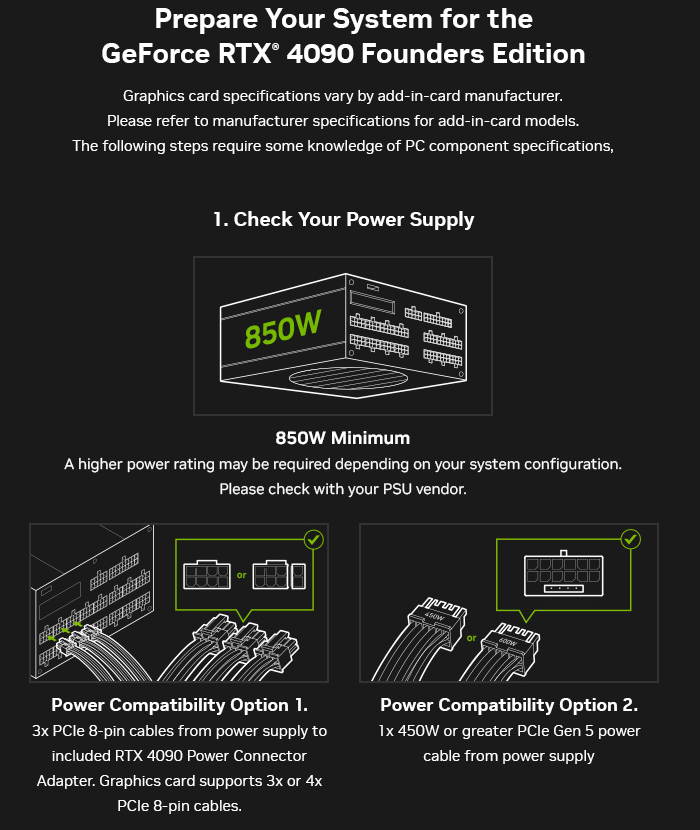
High-performance graphics cards often require additional power beyond what the PCIe slot can offer. Make sure your GPU has enough power to run itself (GPUs can vary significantly from around 75 watts up to 1000 watts for high-end models).
Each GPU needs a PCIe cable with six or eight pins to function properly. Keep in mind that the 6-pin power cable delivers 75 watts and the 8-pin power cable delivers 150 watts. Therefore, verify your GPU’s requirements and choose the appropriate cable accordingly. By connecting the appropriate cable, you can hopefully resolve the error message.
To check your GPU’s power requirements, refer to the specifications provided by the GPU manufacturer (check the manufacturer’s website/product documentation/product packaging). It is usually expressed in terms of the recommended wattage for the power supply unit (PSU) and the number and type of PCIe power connectors required.
3] Check the Power Supply Unit
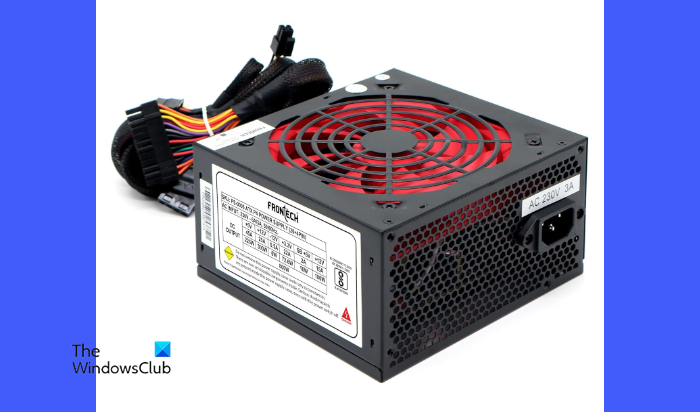
Make sure the specifications of your Power Supply Unit (PSU) are compatible with your GPU’s power requirements. It is generally recommended to have a PSU with some extra headroom (around 100-150W ) above the GPU’s and CPU’s power requirements to accommodate other system components and ensure stable power delivery in case of a power surge.
If your PSU is not working properly or not providing enough wattage to support all the components in your system, you may encounter the above error message. Test the PSU with a power supply tester to check for any faults. If your current PSU is malfunctioning or not able to handle the load, you may need to upgrade it to fix the issue.
4] Use the on-board graphics
To get a better insight into this issue, remove the external graphic adapter from your computer and start the computer with the onboard graphics. This is important because it will help us understand if the issue is with the external graphic adapter. Every computer has some graphics prowess that can at least allow it to open your operating system nonchalantly. If the computer opens without the error message, move to the next solution, as we will discuss what could have happened in detail.
Read: Integrated or Dedicated Graphics card – Which do I need?
5] Re-seat the Graphics Card

An improperly set GPU is another possible cause of the error. Power down your PC, unplug it from the power source, open the case, and carefully remove the graphics card. Then, clean the PCIe lane, re-insert the card back into the PCIe slot, and reconnect the power cables. It may now draw enough power to run without issues.
6] Re-insert the CMOS battery
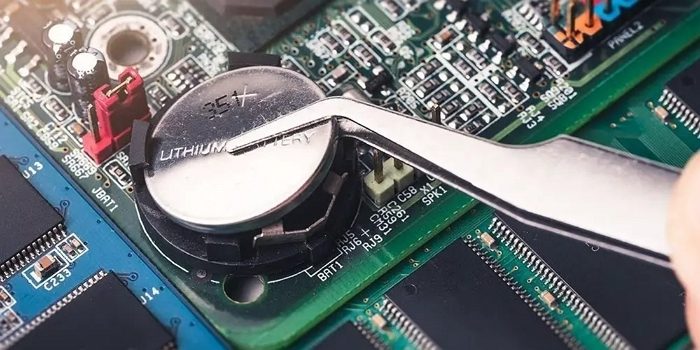
If the device is not receiving appropriate power or there is a hardware configuration conflict, the computer might ask us to recheck the connection. Since we suspect that the issue is related to a configuration conflict, we need to reset the CMOS (Complementary Metal-Oxide-Semiconductor) to resolve it. The CMOS battery is usually located on your computer’s motherboard, and it stores the system’s BIOS settings. By resetting it, we can eliminate any unusual behaviors that might be causing the error. Follow the steps mentioned below to reset your CMOS battery.
- Open the laptop’s back panel, or if you have a desktop, then open the side panel.
- Find out the coin-sized CMOS battery on the motherboard and remove it.
- Once you remove it, wait a minute, reinsert the battery, and reboot the computer.
When the computer is started again, the said error will be resolved.
Read: Signs or symptoms of a CMOS battery failure
7] Contact the manufacturer of your GPU
If all else fails, we are afraid that you might have to contact the manufacturer of your Graphics Card and ask them to resolve the issue. If your device is under warranty, ask for a replacement, otherwise, ask for a permanent solution, so that, you don’t face any issues in the long run.
Read: PCI device driver missing; Where do I download it?
What is PCIe power cable for graphics card?
A PCIe (Peripheral Component Interconnect Express) power cable is a type of power cable used to provide additional power to high-performance graphics cards. Most modern graphics cards (those designed for gaming or other demanding tasks) require additional power beyond what the motherboard can provide through the PCIe slot alone. PCIe power cables are used to connect the graphics card directly to the power supply unit to meet the increased power demands of these GPUs.
Read: Fix BIOS Power-On Self-Test (POST) errors on Windows computers
What is the power limit of a PCIe power cable?
The power limits of a PCIe power cable depend on several factors and may vary depending on the cable’s design and intended use. For example, a 6-pin power cable can provide up to 75 watts, while an 8-pin power cable can provide up to 150 watts to the graphics card.
Read: How to test the Power Supply Unit (PSU) of your computer.
Does GPU need PCIe power?
It’s worth noting that not all graphics cards require an external power source. Some older and lower-end graphics cards can draw enough power through the slot they’re plugged into. However, it’s important to remember that modern high-end graphics cards generally require an external power source, as the PCIE slot alone cannot deliver enough power to satisfy their energy needs.
Also Read: What are SATA power cables used for and what are their types?
Leave a Reply